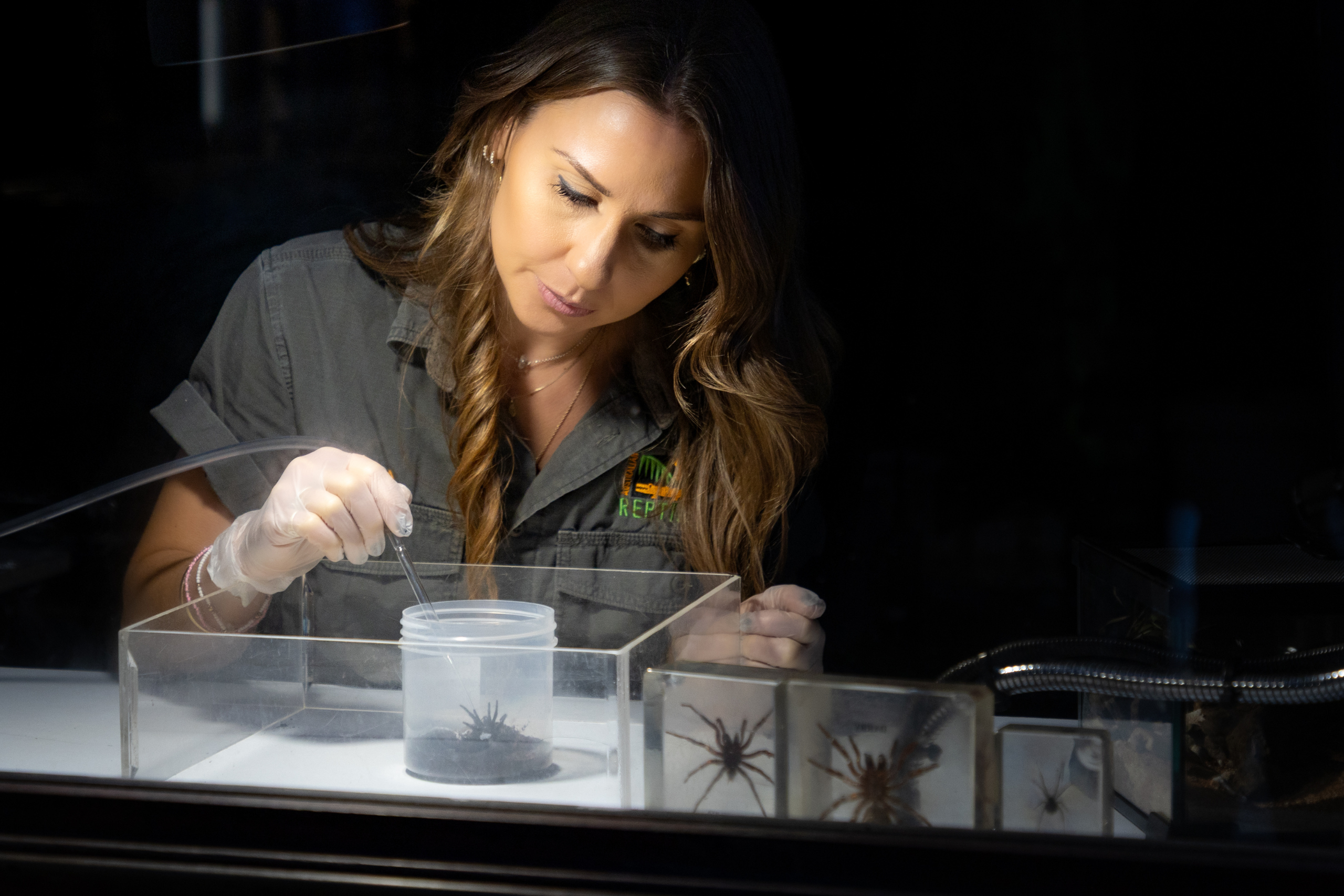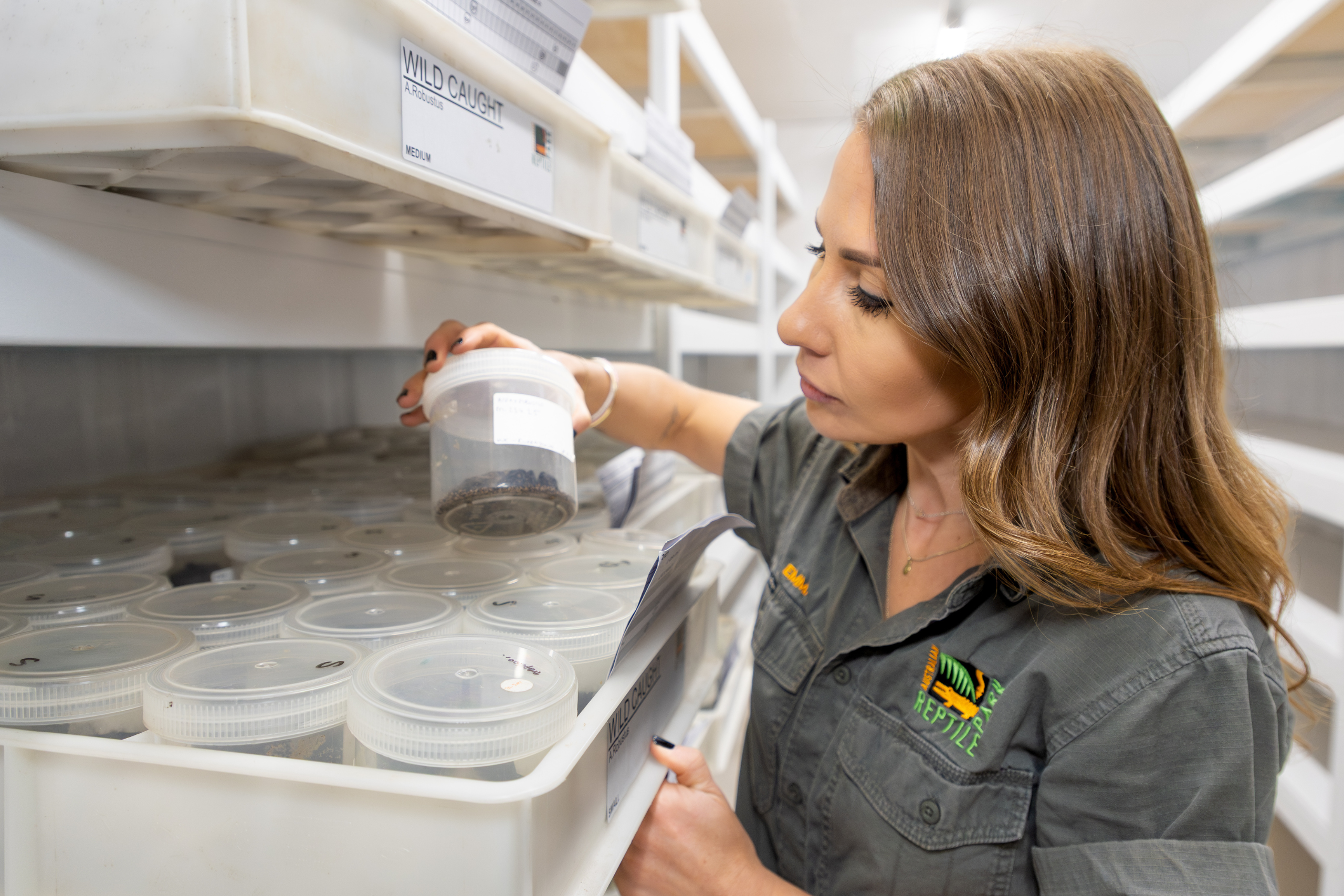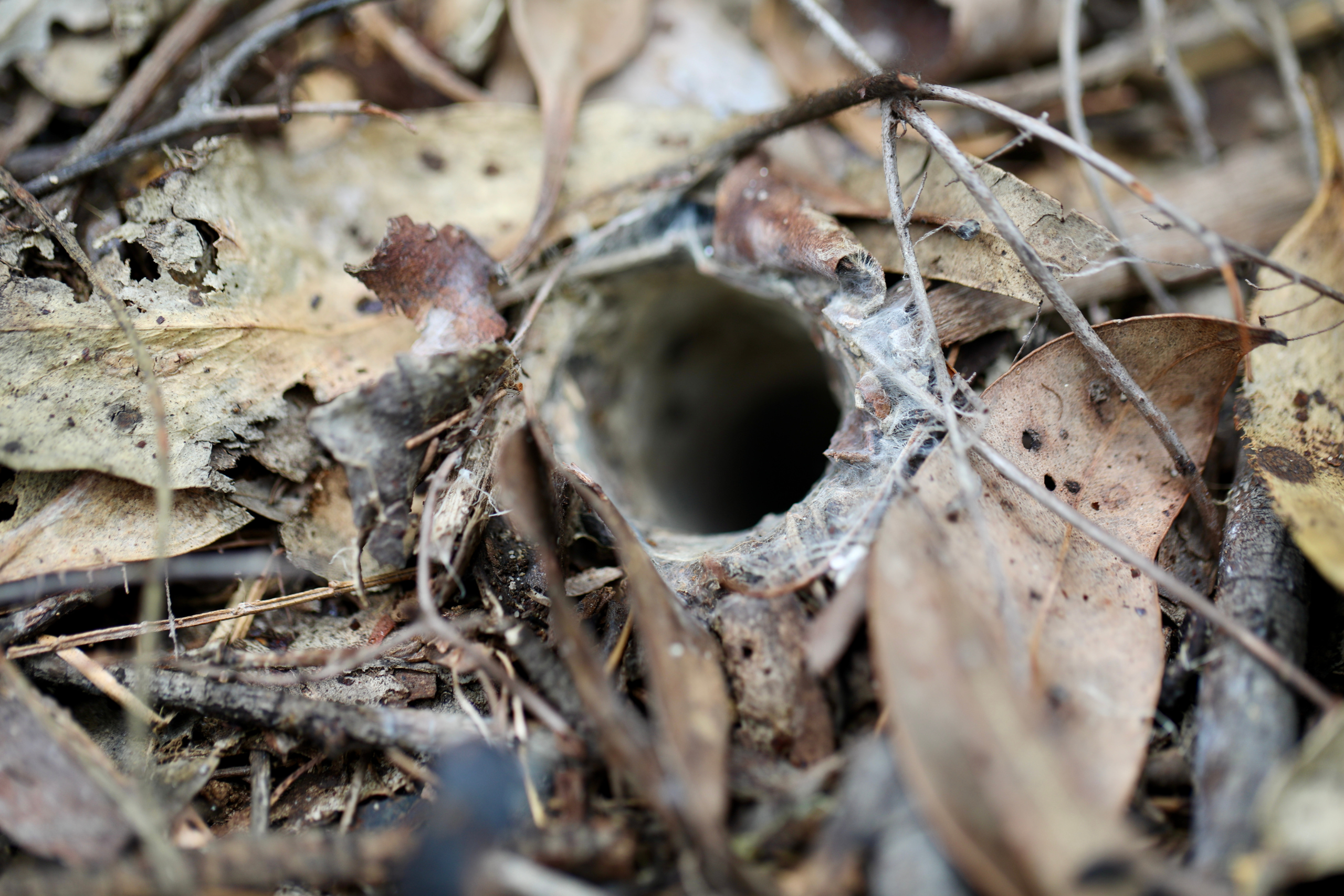Australia’s Most Dangerous Spider?
Funnel web spiders are one of Australia’s most recognised and feared arachnids. With an intimidating stance, shiny black body, and highly toxic venom, this species is widely considered the world’s most venomous spider. If you get bitten, here’s what to do. These spiders have more to offer than just a frightening bite. Found across eastern areas of Australia, funnel web spiders are important to Australia’s environment.
There are more than 30 recognised species of funnel web spiders in Australia. While many of these spiders pose no threat to humans, a few are considered very dangerous. The notorious Sydney funnel web spider (Atrax robustus) delivers a bite that is still considered life-threatening, as its venom contains powerful neurotoxins that affect the human nervous system; before antivenom was developed, these bites often proved fatal.
At the Australian Reptile Park, we educate visitors about these fascinating spiders. We also run the only funnel web spider venom milking program in the country, which has saved countless lives since its inception.
Identification: What Does a Funnel Web Spider Look Like?
Funnel web spiders are typically sturdy, glossy black spiders with a hard carapace, large fangs, and long, strong legs. Their bodies can grow up to 5 centimetres long, with leg spans ranging from 7 to 10 centimetres depending on the species.
Key features include:
- Are glossy black or dark brown, though colour can vary
- Prominent fangs that can pierce fingernails
- A defensive posture when threatened, with fangs raised and front legs extended
- Spinnerets (silk-producing organs) that clearly extend from the rear

These traits set funnel web spiders apart from trapdoor spiders, mouse spiders, and other lookalikes.
The Danger: Funnel Web Spider Bites
Most funnel web spider species are less dangerous than the Sydney funnel web spider. The Sydney species was responsible for most medically significant bites and human fatalities before the development of antivenom.
What makes it so dangerous?
- The male Sydney funnel web spider (Atrax robustus) produces venom containing a neurotoxic compound known as atracotoxin.
- This venom affects the human nervous system, leading to severe and rapid symptoms.
Symptoms of a bite may include:
- Tingling or numbness around the mouth
- Sweating
- Muscle twitching or spasms
- Difficulty breathing
- Increased heart rate or blood pressure
- Increased saliva production
If you’re bitten, applying a compression and immobilisation bandage is really important to slow the venom before getting to hospital for treatment. Without quick medical help, bites can be deadly. Luckily, since funnel web spider antivenom became available in 1981, there haven’t been any recorded deaths.
What to Do if You Encounter a Funnel Web Spider
If you come across a funnel web spider, do not touch or provoke it. If you feel confident to collect a spider for our venom program here’s what to do:
- Put a jar next to the spider and keep fingers at a safe distance
- Then using a large metal spoon or ruler, gently encourage the spider into the jar
- Put some damp soil or a damp cotton ball into the jar
- Close the jar securely
- Bring the spider to a drop-off point like the Australian Reptile Park or a participating hospital or vet clinic in Sydney, Newcastle or the Central Coast.
If bitten by the spider:
- Keep the bite victim calm and immobile.
- Remove any jewellery from the affected limb.
- Apply a pressure-immobilisation bandage firmly around the bite site, wrapping down the limb and back up again.
- Further restrict movement by applying a splint (only if option is nearby).
- Go straight to hospital or call 000
If you want to ensure you’re prepared for snake or funnel-web spider season, specialised compression bandages and comprehensive survival kits are available to purchase.
The Role of the Australian Reptile Park in Antivenom Production

The Australian Reptile Park is home to over 5,000 funnel web spiders and is Australia’s only funnel web spider venom-milking program. Every year, we safely collect raw venom from thousands of spiders, which is then frozen and sent to CSL Seqiris in Melbourne to make lifesaving antivenom.
The CSL Seqirus team injects tiny, non-lethal amounts of venom into rabbits to trigger an immune response. Over about six months, the venom dose is gradually increased until the rabbits can tolerate six times the lethal amount. Then, blood is collected from the rabbits and spun in a centrifuge to separate the antibodies. These antibodies are what’s used to make the antivenom.
Visitors can witness live milking demonstrations, learn about the venom extraction process, and understand how this work contributes to public health. We also accept spider and egg sac donations from the public through our spider drop-off program, helping maintain a steady supply of spider venom donors.
Funnel Web Breeding Program

The Australian Reptile Park’s Funnel Web Breeding Program began in 2019 as a forward-thinking initiative to safeguard the future of our vital antivenom production.
With public donations of funnel web spiders fluctuating, we wanted to explore whether breeding our own spiders could supplement public drop-offs and ensure a steady venom supply year-round.
How It Works
Our spider container currently houses around 5,000 spiderlings. Each spiderling is fed weekly for the first six months, then fortnightly as they grow over the next 3 to 3.5 years until they reach maturity.
- Female spiders may be released back into wild or placed in the breeding program to produce precious egg sacs
- Male spiders enter the lifesaving antivenom program and are milked regularly for their venom
By breeding spiders ourselves, we can better predict venom yields and guarantee we meet the demands of the venom program regardless of seasonal variations or donation numbers.
Pioneering Research and Progress
Spider breeding in captivity is complex and little understood. Since launching the program, we’ve been learning and refining our approach.
In 2023, we successfully bred our first spiders which is a major milestone. This achievement was possible thanks to detailed observations from the spider facility, which helped us develop a dedicated breeding facility. Factors like the diurnal lighting pattern, temperature control, and humidity, especially around egg sacs, have been critical to overcoming breeding challenges.
Looking Ahead
From 2022 to 2025, we’ve doubled the size and capacity of our spider facility, reflecting the program’s success and our commitment to its future. We’re excited to keep expanding this pioneering effort to secure the ongoing consistent production of lifesaving antivenom.
Habitat: Where Are Funnel Web Spiders Found?
Funnel web spiders prefer cool, humid environments, often in shady spots protected from direct sunlight. They are mostly found in the eastern regions of Australia, especially along the east coast of New South Wales and parts of Queensland.
You’re most likely to find them:
- Under logs or rocks in bushland and forests
- In gardens or suburban backyards, particularly during wet weather
- Inside silk-lined burrows, often built with a funnel-shaped entrance and trip lines extending outward
- Occasionally in swimming pools, where males can fall while exploring and can remain alive underwater for extended periods
Although funnel web spiders are often found in populated areas, they are not naturally aggressive towards humans. They act defensively and will only bite if threatened or accidentally disturbed.
Behaviour and Seasonal Activity
Funnel web spiders are mainly active at night. They spend most of their time hidden in burrows or crevices, waiting for prey. However, during the warmer months, especially from November to April, male funnel webs become much more active and visible as they wander in search of mates, leading to more frequent encounters.
During this time:
- Male Sydney funnel web spiders leave their burrows to search for mates
- This wandering is most common after rainfall followed by warm weather
- This behaviour increases the chances of encounters with humans
Males are much more dangerous than females due to the structure of their venom, which contains a potent neurotoxin that can be fatal if untreated.
Silk-Lined Burrows and Hunting Tactics
Despite their intimidating appearance, funnel web spiders are ambush predators that rely on stealth and patience. They rarely chase prey. Instead, they use their silk-lined burrows as sensory traps, picking up vibrations through strands of silk. When a suitable meal walks across their trip lines, the spider quickly rushes out to deliver a venomous bite.

Their diet includes:
- Insects like beetles, crickets, and cockroaches
- Other spiders
- Small reptiles such as lizards
- Occasionally, tiny frogs
Their fangs inject venom into the prey, which quickly immobilises it. The spider then pulls the prey back into the burrow to eat.
Life Cycle and Reproduction
Funnel web spiders reproduce during the summer and autumn months, when wandering males use chemical signals to find females. Once a male locates a female, he performs a courtship ritual that involves leg tapping and vibrations.

If accepted:
- The pair mates inside the female’s burrow
- The female funnel web lays an egg sac that usually contains 80 to 100 eggs, though sometimes there can be as many as 250.
- She guards the sac inside her burrow until the spiderlings hatch
- Young spiders remain with the mother briefly before dispersing to establish their own territories
Female Sydney funnel web spiders live long lives, often reaching up to 25 years in the wild. Males have much shorter lives, usually dying within a year of reaching maturity.
Tree-Dwelling Funnel Web Spiders and Other Species
While many people associate funnel web spiders with ground burrows, some species, such as the northern tree-dwelling funnel web spider, live in tree hollows and high vegetation.
Other species include:
- Newcastle Funnel-web Spider (Atrax Christenseni)
- The Blue Mountains funnel web
- The Southern tree-dwelling funnel web
- The Northern Rivers funnel web
These all belong to the Hadronyche or Atrax group and share similar traits: strong fangs, silk-spinning behaviour, and, in some cases, venom that can harm humans.
Funnel Web Spiders and Their Place in the Ecosystem
Funnel web spiders might seem scary, but they play a crucial role in the environment:
- Pest control: they help keep insect populations in check
- Prey for larger animals: some birds and reptiles eat funnel webs
- Medicine: their venom is used to produce antivenom and is also being researched for use in pain relief, stroke treatment, and heart attack recovery
Understanding and respecting these spiders, rather than fearing them, can help protect both people and spiders.



